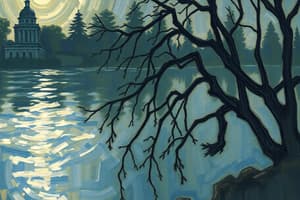Podcast
Questions and Answers
How can artists create a strong composition using the Rabatment of the Square?
How can artists create a strong composition using the Rabatment of the Square?
- By drawing armatures within the rectangle
- By using contrasting colors in the composition
- By filling both positive and negative spaces equally
- By placing focal points along the lines of rabatment (correct)
Which technique can be used to create a sense of depth and movement within an artwork?
Which technique can be used to create a sense of depth and movement within an artwork?
- Contrast and Isolation
- Scale and Perspective
- Armature of the Rectangle (correct)
- Color Choice
How can artists draw attention to specific elements in the composition?
How can artists draw attention to specific elements in the composition?
- By using contrast and isolation (correct)
- By filling all spaces with elements
- By only using warm colors
- By using a limited color palette
What do positive and negative spaces refer to in an artwork?
What do positive and negative spaces refer to in an artwork?
How do scale and perspective contribute to artwork?
How do scale and perspective contribute to artwork?
Flashcards are hidden until you start studying
Study Notes
Composition Techniques in Art Supplies
Composition techniques are essential in creating visually appealing and balanced artwork. These techniques involve the arrangement of various elements within a piece to create harmony and a sense of order. Over the years, artists have developed various systems and rules for creating compositions that reflect their cultural values and artistic movements. In this article, we will explore some of the composition techniques used in art and how they can be applied using art supplies.
The Golden Rectangle
One of the most fundamental composition techniques is the Golden Rectangle, which is based on the ratio of 1:1.618. This ratio is believed to be aesthetically pleasing and can be found in many works of art. To create a composition using the Golden Rectangle, artists can divide their canvas into equal squares, with the longer side being the height of the rectangle. By placing key elements along these lines, artists can create a balanced and harmonious composition.
The Rule of Thirds
The Rule of Thirds is another popular composition technique that involves dividing the canvas into thirds horizontally and vertically, creating nine equal squares. The idea is to place the most important elements of the composition along these lines or at their intersections. This technique helps to create a sense of balance and proportion in the artwork.
The Rabatment of the Square
The Rabatment of the Square is a technique that involves finding the two lines of rabatment in a rectangle, which are the lines that divide the rectangle into two implied squares. By placing focal points along these lines, artists can create a strong composition that meets the viewer's subconscious expectation.
The Armature of the Rectangle
The Armature of the Rectangle is a more complex composition technique that involves drawing lines within a rectangle to create a network of lines that can be used as a guide for placing elements in the composition. This technique can be used to create a sense of depth and movement within the artwork.
Contrast and Isolation
Contrast and isolation are techniques that involve using difference in color, texture, or size to draw attention to specific elements in the composition. By isolating key elements and creating contrast with their surroundings, artists can create a sense of emphasis and hierarchy within the artwork.
Color Choice
Color choice is another important aspect of composition in art. The use of complementary colors can create a sense of harmony and balance in the composition, while the use of contrasting colors can create tension and energy. Additionally, the use of warm and cool colors can create a sense of mood and atmosphere in the artwork.
Positive and Negative Spaces
Positive and negative spaces refer to the areas of an artwork that are filled with elements (positive space) and the areas that are empty (negative space). By carefully balancing the use of positive and negative spaces, artists can create a sense of harmony and balance in the composition.
Scale and Perspective
Scale and perspective are techniques that involve using size and depth to create a sense of space and movement within the artwork. By carefully manipulating the scale and perspective of elements in the composition, artists can create a sense of depth and three-dimensionality in the artwork.
Using Art Supplies
To implement these composition techniques, artists can use a variety of art supplies, including:
- Pencils: Pencils are great for sketching out initial compositions and making fine adjustments.
- Paintbrushes: Different brush shapes and sizes can be used to create different textures and effects in the artwork.
- Paint: A variety of paints can be used to create contrast and color in the artwork.
- Canvases: Canvases come in various sizes and shapes, allowing artists to choose the best format for their composition.
- Drawing Tools: Tools like rulers and compasses can be used to create precise lines and shapes in the artwork.
In conclusion, composition techniques are an essential aspect of creating visually appealing and balanced artwork. By understanding and applying these techniques using various art supplies, artists can create compositions that engage and captivate their viewers.
Studying That Suits You
Use AI to generate personalized quizzes and flashcards to suit your learning preferences.




